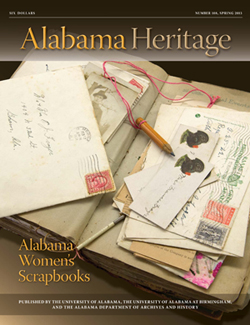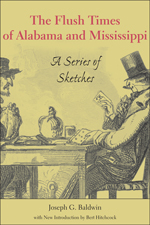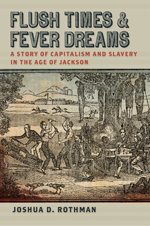|
On the cover: The scrapbook of Frances Frazer in the A. S. Williams III Americana Collection. (Robin McDonald)
|
FEATURE ABSTRACTS
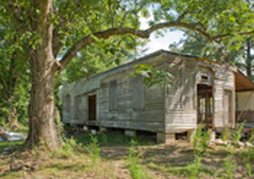 2012: Cedarwood awaits the moving truck.
2012: Cedarwood awaits the moving truck. (Robin McDonald)
History on the Move: The Past, Present, and Future of Cedarwood
By Valerie Pope Burnes
When Joseph Blodget Stickney arrived in the Alabama Territory in 1818, he likely had little reason to expect that nearly two centuries later, Cedarwood—the house he constructed for his family—would still be standing, or that it would be standing many miles from its original location. Stickney built Cedarwood on property he received from Gen. Charles Lefebvre Desnouettes, who was instrumental in establishing the Vine and Olive Colony. After generations of use—and numerous expansions—Cedarwood was relocated from its site near Greensboro to another site near Moundville. In 2012 it moved again, this time settling on the campus of the University of West Alabama and passing from private ownership into the care of an institution prepared to preserve its unique heritage as a home older than the state itself. Thanks to the work of many, Cedarwood remains—not quite where Stickney constructed it, but still offering lessons on its origin in the land that would become the state of Alabama.
Additional Information
University students who participate in "Lights, Camera, Alabama" -- through the University of Alabama Honors College and under the direction of Billy Field -- have produced a movie on historic Cedarwood, which can be viewed here.
About the Author
Valerie Pope Burnes is an assistant professor of history and director of the Center for the Study of the Black Belt at the University of West Alabama (UWA) in Livingston. A native of Talladega, Alabama, Burnes became interested in preservation in first grade, when her teacher took her class on a walk in the Silk Stocking District neighborhood that surrounded her elementary school. Her “ah-hah” moment came when she saw the Purefoy Home on South Street. She realized the beauty of architecture and learned not to dismiss structures just because they are old. She and her husband Brian have restored four homes in Marion, as well as their current home in Livingston. Cedarwood is one of four structures on the UWA campus in which Burnes has been involved in the moving and restoration process.
By Valerie Pope Burnes
When Joseph Blodget Stickney arrived in the Alabama Territory in 1818, he likely had little reason to expect that nearly two centuries later, Cedarwood—the house he constructed for his family—would still be standing, or that it would be standing many miles from its original location. Stickney built Cedarwood on property he received from Gen. Charles Lefebvre Desnouettes, who was instrumental in establishing the Vine and Olive Colony. After generations of use—and numerous expansions—Cedarwood was relocated from its site near Greensboro to another site near Moundville. In 2012 it moved again, this time settling on the campus of the University of West Alabama and passing from private ownership into the care of an institution prepared to preserve its unique heritage as a home older than the state itself. Thanks to the work of many, Cedarwood remains—not quite where Stickney constructed it, but still offering lessons on its origin in the land that would become the state of Alabama.
Additional Information
University students who participate in "Lights, Camera, Alabama" -- through the University of Alabama Honors College and under the direction of Billy Field -- have produced a movie on historic Cedarwood, which can be viewed here.
About the Author
Valerie Pope Burnes is an assistant professor of history and director of the Center for the Study of the Black Belt at the University of West Alabama (UWA) in Livingston. A native of Talladega, Alabama, Burnes became interested in preservation in first grade, when her teacher took her class on a walk in the Silk Stocking District neighborhood that surrounded her elementary school. Her “ah-hah” moment came when she saw the Purefoy Home on South Street. She realized the beauty of architecture and learned not to dismiss structures just because they are old. She and her husband Brian have restored four homes in Marion, as well as their current home in Livingston. Cedarwood is one of four structures on the UWA campus in which Burnes has been involved in the moving and restoration process.
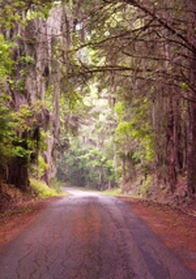 This stretch of Old Federal Road appears much as it did two hundred years ago. (Mark Dauber)
This stretch of Old Federal Road appears much as it did two hundred years ago. (Mark Dauber)
Exploring the Old Federal Road
By Mark Dauber
In the early 1800s when surveyors began exploring the land that would become the Federal Road and ease passage between Washington, DC, and southern ports, they faced rough and wild terrain known, if at all, only by Creek Indian tribes. Soon, though, that land became much more passable, aided in part by manipulation—and at times, outright defiance—of long-standing treaties protecting the Native Americans’ claims to the land. Using various means, including the threat of impending war with Britain, the government gained the necessary land to create the Federal Road. For several decades, it offered a significant and much-traveled route, aiding the advent of “Alabama Fever” as settlers used it to move into the new state. Though it eventually fell into decline as trains and steamboats offered more efficient means of transport, today the Federal Road remains an important component of Alabama’s transportation history.
By Mark Dauber
In the early 1800s when surveyors began exploring the land that would become the Federal Road and ease passage between Washington, DC, and southern ports, they faced rough and wild terrain known, if at all, only by Creek Indian tribes. Soon, though, that land became much more passable, aided in part by manipulation—and at times, outright defiance—of long-standing treaties protecting the Native Americans’ claims to the land. Using various means, including the threat of impending war with Britain, the government gained the necessary land to create the Federal Road. For several decades, it offered a significant and much-traveled route, aiding the advent of “Alabama Fever” as settlers used it to move into the new state. Though it eventually fell into decline as trains and steamboats offered more efficient means of transport, today the Federal Road remains an important component of Alabama’s transportation history.
Additional Information
For detailed maps of the Old Federal Road in Alabama, visit the website.
About the Author
Mark Dauber is a fine art photographer born in Birmingham, Alabama. He has had numerous exhibits throughout the United States, and his work is included in various private and institutional collections. Dauber has led his own workshops in various international locations, including Guatemala. In 1991 he produced the architectural photography for the highly praised exhibit and catalogue, Palladio In Alabama. Dauber’s work is primarily influenced by his friend and teacher, Paul Caponigro, who is universally regarded as one of the great masters of fine art photography. Dauber has served as a teaching and darkroom assistant to Caponigro, both in Ireland and in Maine in the acclaimed Maine Photographic Workshops, and now is teaching workshops at The Dauber Gallery and elsewhere. Dauber’s study of the Old Federal Road began almost twenty-five years ago. He has been stumbling down its historic past with camera in tow ever since. Dauber currently lives with his wife Margaret on a farm in Pintlala, Alabama. He can be contacted by email, or at (334) 538-4677. You can view some of his work at his website or at his Montgomery gallery, The Dauber Gallery.
For detailed maps of the Old Federal Road in Alabama, visit the website.
About the Author
Mark Dauber is a fine art photographer born in Birmingham, Alabama. He has had numerous exhibits throughout the United States, and his work is included in various private and institutional collections. Dauber has led his own workshops in various international locations, including Guatemala. In 1991 he produced the architectural photography for the highly praised exhibit and catalogue, Palladio In Alabama. Dauber’s work is primarily influenced by his friend and teacher, Paul Caponigro, who is universally regarded as one of the great masters of fine art photography. Dauber has served as a teaching and darkroom assistant to Caponigro, both in Ireland and in Maine in the acclaimed Maine Photographic Workshops, and now is teaching workshops at The Dauber Gallery and elsewhere. Dauber’s study of the Old Federal Road began almost twenty-five years ago. He has been stumbling down its historic past with camera in tow ever since. Dauber currently lives with his wife Margaret on a farm in Pintlala, Alabama. He can be contacted by email, or at (334) 538-4677. You can view some of his work at his website or at his Montgomery gallery, The Dauber Gallery.
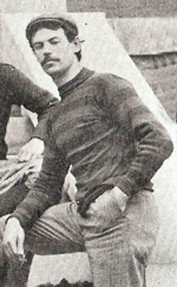 John Heisman, 1896.
John Heisman, 1896. (Auburn University Archives>
Coach John Heisman on Stage at Auburn
By Ralph Draughon Jr.
Although best known for the trophy bearing his name, John Heisman also left quite an impression on the Auburn community—not just as the university’s football coach, but as an actor. Ralph Draughon Jr. takes readers through a fascinating profile of Heisman, showing how the qualities that helped him win football games stemmed from his training as an actor. The symbiosis did not end there: at times when the Alabama Polytechnic Institute (as Auburn University was known in Heisman’s day) football team struggled financially, Heisman and the A.P.I. Dramatic Club came to the rescue, staging plays and earning the necessary funds to keep the football team financially solvent. Ever the showman, Heisman himself starred in many of these productions, regaling audiences with his portrayals of disparate characters drawn from Shakespeare, everyday life, and many sources in between. The A.P.I. Dramatic Club remains relatively unknown among the contemporary Auburn Community, but Draughton’s article reminds us of the value of dramatic arts—and of the coach who loved them.
Additional Information
For more information on John Heisman, please see the Encyclopedia of Alabama article on him.
For a general overview of the Auburn University football program’s history, read a lecture transcript on the Auburn University website.
About the Author
Ralph Draughon Jr. is serving his second six-year term on the Alabama Historical Commission and has been actively involved in the Alabama Historical Association and the Alabama Trust for Historic Preservation. With an MA and PhD in southern history from UNC-Chapel Hill, he taught at the University of Georgia, established a research center at Stratford Hall (Robert E. Lee’s birthplace in Virginia), served as curator at the Historic New Orleans Collection, and acted as historical advisor to a major national archeological firm. He also served as associate director and helped initiate in 1980 the Monticello-Stratford Hall Seminar on Colonial and Revolutionary America. An example of the then new idea of holding summer seminars for school teachers, the seminar received a commendation from the American Association of State and Local History. Recently, Draughon has co-authored Lost Auburn: A Village Remembered in Period Photographs (New South Press).
By Ralph Draughon Jr.
Although best known for the trophy bearing his name, John Heisman also left quite an impression on the Auburn community—not just as the university’s football coach, but as an actor. Ralph Draughon Jr. takes readers through a fascinating profile of Heisman, showing how the qualities that helped him win football games stemmed from his training as an actor. The symbiosis did not end there: at times when the Alabama Polytechnic Institute (as Auburn University was known in Heisman’s day) football team struggled financially, Heisman and the A.P.I. Dramatic Club came to the rescue, staging plays and earning the necessary funds to keep the football team financially solvent. Ever the showman, Heisman himself starred in many of these productions, regaling audiences with his portrayals of disparate characters drawn from Shakespeare, everyday life, and many sources in between. The A.P.I. Dramatic Club remains relatively unknown among the contemporary Auburn Community, but Draughton’s article reminds us of the value of dramatic arts—and of the coach who loved them.
Additional Information
For more information on John Heisman, please see the Encyclopedia of Alabama article on him.
For a general overview of the Auburn University football program’s history, read a lecture transcript on the Auburn University website.
About the Author
Ralph Draughon Jr. is serving his second six-year term on the Alabama Historical Commission and has been actively involved in the Alabama Historical Association and the Alabama Trust for Historic Preservation. With an MA and PhD in southern history from UNC-Chapel Hill, he taught at the University of Georgia, established a research center at Stratford Hall (Robert E. Lee’s birthplace in Virginia), served as curator at the Historic New Orleans Collection, and acted as historical advisor to a major national archeological firm. He also served as associate director and helped initiate in 1980 the Monticello-Stratford Hall Seminar on Colonial and Revolutionary America. An example of the then new idea of holding summer seminars for school teachers, the seminar received a commendation from the American Association of State and Local History. Recently, Draughon has co-authored Lost Auburn: A Village Remembered in Period Photographs (New South Press).
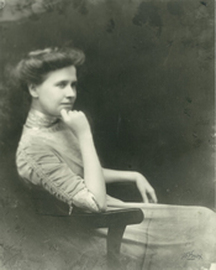 Mary Norman Moore,
Mary Norman Moore, the first female president
of Athens Female College
(Athens State University Archives)
A Force of Nature: Mary Norman Moore
By Ann Marie Lang
Although Athens State University now serves approximately 3,500 graduate and undergraduate students in a vibrant educational system, the institution’s future was not always so bright. Back at the turn of the twentieth century, the school (then known as Athens Female College) had suffered from administrative instability and infrastructure issues. Luckily for AFC—and for the many generations of students who have attended Athens State in the century since that time—the school hired Mary Norman Moore as its new president. Serving in two different terms, Moore helped develop the institution’s identity, bolster its endowment, earn appropriate accreditation, and cement its place in the state’s roster of valuable educational entities. However, in keeping with Moore’s humility, little is known about her valuable role—a situation author Ann Marie Lang serves to remedy in articles such as this one, which highlight the significance one woman had on her community and its youth.
Additional Information
For more information on Athens State University, please see its website.
For an overview of the institution’s history, please read the Encyclopedia of Alabama article on the topic.
About the Author
Ann Marie Lang made the decision to return to school to complete her college education in 2009. She succeeded in earning a BA in history (cum laude) from Athens State University in December 2011. Lang had a successful seventeen-year sales career, and prior to that served twelve years in the US Navy. She is a proud mother and grandmother, and she has the marvelous support of her husband of thirteen years, Gene. While enrolled at Athens State, Dr. Ronald Fritze, dean of College of Arts and Sciences, asked Lang if she would consider an independent study project based on the life of a past president of Athens State, Mary Moore McCoy. She took nearly a year to complete the project, focusing much of her efforts on original research on President McCoy’s early life in Huntsville. Prior to the paper, President McCoy’s life story had largely been lost to history. For the 200th anniversary of Athens State University, Dr. Fritze hopes to publish this biography along with republishing the history of Athens State that President McCoy wrote in 1916.
By Ann Marie Lang
Although Athens State University now serves approximately 3,500 graduate and undergraduate students in a vibrant educational system, the institution’s future was not always so bright. Back at the turn of the twentieth century, the school (then known as Athens Female College) had suffered from administrative instability and infrastructure issues. Luckily for AFC—and for the many generations of students who have attended Athens State in the century since that time—the school hired Mary Norman Moore as its new president. Serving in two different terms, Moore helped develop the institution’s identity, bolster its endowment, earn appropriate accreditation, and cement its place in the state’s roster of valuable educational entities. However, in keeping with Moore’s humility, little is known about her valuable role—a situation author Ann Marie Lang serves to remedy in articles such as this one, which highlight the significance one woman had on her community and its youth.
Additional Information
For more information on Athens State University, please see its website.
For an overview of the institution’s history, please read the Encyclopedia of Alabama article on the topic.
About the Author
Ann Marie Lang made the decision to return to school to complete her college education in 2009. She succeeded in earning a BA in history (cum laude) from Athens State University in December 2011. Lang had a successful seventeen-year sales career, and prior to that served twelve years in the US Navy. She is a proud mother and grandmother, and she has the marvelous support of her husband of thirteen years, Gene. While enrolled at Athens State, Dr. Ronald Fritze, dean of College of Arts and Sciences, asked Lang if she would consider an independent study project based on the life of a past president of Athens State, Mary Moore McCoy. She took nearly a year to complete the project, focusing much of her efforts on original research on President McCoy’s early life in Huntsville. Prior to the paper, President McCoy’s life story had largely been lost to history. For the 200th anniversary of Athens State University, Dr. Fritze hopes to publish this biography along with republishing the history of Athens State that President McCoy wrote in 1916.
DEPARTMENT ABSTRACTS
 A sandhill crane
A sandhill crane at Wheeler National Wildlife Refuge
(Wheeler National Wildlife Refuge)
Alabama Treasures
Wheeler National Wildlife Refuge
By Thomas V. Ress
Prior to the 1930s, the area now known as the Wheeler National Wildlife Refuge (NWR) remained an under-utilized expanse where tens of thousands of acres languished, waiting for a purpose. That purpose arrived with the construction of the Tennessee Valley Authority (TVA) dams along the Tennessee River. As the first such refuge in the state, the Wheeler NWR proved that allocating land for environmental purposes could have a valuable impact on animal populations. Today, the refuge lives up to its name, offering protected habitats to nearly eighty thousand birds along with a diverse range of other animals. As Wheeler NWR celebrates its seventy-fifth anniversary this year, we’re reminded of the value of setting aside land to help nurture the world around us.
Additional Information
For more information about Wheeler NWR, please see its website or the website of the Wheeler Wildlife Refuge Association, an independent group organized to support the refuge.
For an exploration of a different kind of animal life at Wheeler NWR, please see Thomas Ress’s article “The Tennessee Valley: Gator Country?” in Alabama Heritage 105 (Summer 2012).
About the Author
Thomas V. Ress resides in Athens, Alabama, and is an avid writer and traveler who blogs at Dispatches from the Wild World. His articles have appeared in numerous magazines and newspapers.
Wheeler National Wildlife Refuge
By Thomas V. Ress
Prior to the 1930s, the area now known as the Wheeler National Wildlife Refuge (NWR) remained an under-utilized expanse where tens of thousands of acres languished, waiting for a purpose. That purpose arrived with the construction of the Tennessee Valley Authority (TVA) dams along the Tennessee River. As the first such refuge in the state, the Wheeler NWR proved that allocating land for environmental purposes could have a valuable impact on animal populations. Today, the refuge lives up to its name, offering protected habitats to nearly eighty thousand birds along with a diverse range of other animals. As Wheeler NWR celebrates its seventy-fifth anniversary this year, we’re reminded of the value of setting aside land to help nurture the world around us.
Additional Information
For more information about Wheeler NWR, please see its website or the website of the Wheeler Wildlife Refuge Association, an independent group organized to support the refuge.
For an exploration of a different kind of animal life at Wheeler NWR, please see Thomas Ress’s article “The Tennessee Valley: Gator Country?” in Alabama Heritage 105 (Summer 2012).
About the Author
Thomas V. Ress resides in Athens, Alabama, and is an avid writer and traveler who blogs at Dispatches from the Wild World. His articles have appeared in numerous magazines and newspapers.
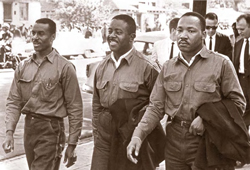 Fred Shuttlesworth,
Fred Shuttlesworth, Ralph Abernathy,
and Martin Luther King Jr.
(Birmingham Public Library)
Becoming Alabama
Quarter by Quarter
By Joseph W. Pearson, Megan L. Bever, and Matthew L. Downs
Editor’s Note: Alabama Heritage, the Summersell Center for Study of the South, the University of Alabama Department of History, and the Alabama Tourism Department offer this department as a part of the statewide "Becoming Alabama" initiative—a cooperative venture of state organizations to commemorate Alabama’s experiences related to the Creek War, the Civil War, and the civil rights movement. Quarter by quarter we will take you to the corresponding seasons 200, 150, and 50 years ago—sometimes describing pivotal events, sometimes describing daily life, but always illuminating a world in flux. We will wait for the ultimate outcomes as our forebears did—over time. For those joining the story in progress, you can find earlier quarters on our website.
This quarter, we explore the contest for Mobile and its valuable bay and Col. John Bowyer’s construction of a fort in that area, Gen. Nathan Bedford Forrest’s ingenious defeat of Gen. Abel D. Streight, and the tumultuous events occurring in Birmingham in the spring of 1963. The latter, which comprised a significant section of the civil rights movement, receive in-depth treatment from author Matthew L. Downs, who describes the Children’s March, Martin Luther King Jr.’s “Letter from a Birmingham Jail,” and the violence that was directed at protestors in Kelly Ingram Park. Throughout these installments, the authors remind us of the important events and trends that shaped our state’s identity.
Additional Information
For more information on Fort Bowyer, please see the National Park Service website.
The Encyclopedia of Alabama has several articles relevant to this quarter’s topics, including:
* Streight’s Raid
* The civil rights movement in Alabama
About the Authors
Joseph W. Pearson is a PhD student in the department of history at the University of Alabama. His research interests include the nineteenth-century South, antebellum politics, and political culture. Megan L. Bever is currently a doctoral student in the department of history at the University of Alabama. Her research interests include the nineteenth-century South and the Civil War in American culture. Matthew L. Downs (PhD, Alabama) is an assistant professor of history at the University of Mobile. His dissertation focused on the federal government’s role in the economic development of the Tennessee Valley.
Quarter by Quarter
By Joseph W. Pearson, Megan L. Bever, and Matthew L. Downs
Editor’s Note: Alabama Heritage, the Summersell Center for Study of the South, the University of Alabama Department of History, and the Alabama Tourism Department offer this department as a part of the statewide "Becoming Alabama" initiative—a cooperative venture of state organizations to commemorate Alabama’s experiences related to the Creek War, the Civil War, and the civil rights movement. Quarter by quarter we will take you to the corresponding seasons 200, 150, and 50 years ago—sometimes describing pivotal events, sometimes describing daily life, but always illuminating a world in flux. We will wait for the ultimate outcomes as our forebears did—over time. For those joining the story in progress, you can find earlier quarters on our website.
This quarter, we explore the contest for Mobile and its valuable bay and Col. John Bowyer’s construction of a fort in that area, Gen. Nathan Bedford Forrest’s ingenious defeat of Gen. Abel D. Streight, and the tumultuous events occurring in Birmingham in the spring of 1963. The latter, which comprised a significant section of the civil rights movement, receive in-depth treatment from author Matthew L. Downs, who describes the Children’s March, Martin Luther King Jr.’s “Letter from a Birmingham Jail,” and the violence that was directed at protestors in Kelly Ingram Park. Throughout these installments, the authors remind us of the important events and trends that shaped our state’s identity.
Additional Information
For more information on Fort Bowyer, please see the National Park Service website.
The Encyclopedia of Alabama has several articles relevant to this quarter’s topics, including:
* Streight’s Raid
* The civil rights movement in Alabama
About the Authors
Joseph W. Pearson is a PhD student in the department of history at the University of Alabama. His research interests include the nineteenth-century South, antebellum politics, and political culture. Megan L. Bever is currently a doctoral student in the department of history at the University of Alabama. Her research interests include the nineteenth-century South and the Civil War in American culture. Matthew L. Downs (PhD, Alabama) is an assistant professor of history at the University of Mobile. His dissertation focused on the federal government’s role in the economic development of the Tennessee Valley.
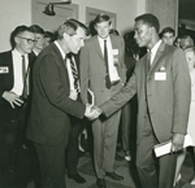 Robert F. Kennedy and James Hood.
Robert F. Kennedy and James Hood. (W.S. Hoole Special Collections Library,
The University of Alabama)
Portraits & Landscapes
The Path to the Schoolhouse Door
By Earl Tilford
Stories describing the desegregation of the University of Alabama often focus on the seminal events that define this process. However, in actuality, the struggle to integrate the state’s flagship campus began much earlier than often realized, and it was made possible by a number of little-known individuals, some of whom came to Alabama specifically for this task. Earl Tilford presents that “behind the scenes” story, showing how many forces and people worked together to allow students of all races to pass through the schoolhouse door.
Additional Information
For information about Frank Rose, the UA president mentioned in Tilford’s article, please see his biographical description on the Alabama Academy of Honor Alabama Academy of Honor website.
For information on the stand in the schoolhouse door, including both historical information and contemporary updates, please visit the University of Alabama’s website.
For an overview of these events, please see the Encyclopedia of Alabama entry for this topic.
About the Author
Earl Tilford, a 1968 graduate of the University of Alabama, earned his doctorate at George Washington University. This article is drawn from his forthcoming book, Turning the Tide: The University of Alabama in the 1960s (University of Alabama Press, 2014).
The Path to the Schoolhouse Door
By Earl Tilford
Stories describing the desegregation of the University of Alabama often focus on the seminal events that define this process. However, in actuality, the struggle to integrate the state’s flagship campus began much earlier than often realized, and it was made possible by a number of little-known individuals, some of whom came to Alabama specifically for this task. Earl Tilford presents that “behind the scenes” story, showing how many forces and people worked together to allow students of all races to pass through the schoolhouse door.
Additional Information
For information about Frank Rose, the UA president mentioned in Tilford’s article, please see his biographical description on the Alabama Academy of Honor Alabama Academy of Honor website.
For information on the stand in the schoolhouse door, including both historical information and contemporary updates, please visit the University of Alabama’s website.
For an overview of these events, please see the Encyclopedia of Alabama entry for this topic.
About the Author
Earl Tilford, a 1968 graduate of the University of Alabama, earned his doctorate at George Washington University. This article is drawn from his forthcoming book, Turning the Tide: The University of Alabama in the 1960s (University of Alabama Press, 2014).
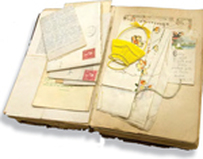 Frances Frazer's book
Frances Frazer's book holds dozens of loose items
(Robin McDonald)
Revealing Hidden Collections
Collected Memory: Alabama Women’s Scrapbooks
By Nancy B. Dupree
Alabama women’s scrapbooks, quite in vogue in the early 1900s, comprise a little-explored component of the A. S. Williams III Americana Collection at the University of Alabama. In turning her attention to these fascinating record books, archivist Nancy Dupree has uncovered valuable information about social and cultural practices of Alabama teens at the turn of the century. These scrapbooks, which reveal the practices and preferences that defined the lives of young women, offer significant primary research to complement the secondary knowledge we have of Alabama women in this period.
About the Author
Nancy DuPree serves as curator of the A. S. Williams III Americana Library at the University of Alabama. She holds degrees from Furman University, Auburn, and the University of Alabama. She has worked at the University of Alabama for more than thirty years. Louis A. Pitschmann, standing editor of the “Revealing Hidden Collections” department of Alabama Heritage, is dean of the University Libraries at the University of Alabama and director of the Alabama Center for the Book, which co-sponsors this department.
Collected Memory: Alabama Women’s Scrapbooks
By Nancy B. Dupree
Alabama women’s scrapbooks, quite in vogue in the early 1900s, comprise a little-explored component of the A. S. Williams III Americana Collection at the University of Alabama. In turning her attention to these fascinating record books, archivist Nancy Dupree has uncovered valuable information about social and cultural practices of Alabama teens at the turn of the century. These scrapbooks, which reveal the practices and preferences that defined the lives of young women, offer significant primary research to complement the secondary knowledge we have of Alabama women in this period.
About the Author
Nancy DuPree serves as curator of the A. S. Williams III Americana Library at the University of Alabama. She holds degrees from Furman University, Auburn, and the University of Alabama. She has worked at the University of Alabama for more than thirty years. Louis A. Pitschmann, standing editor of the “Revealing Hidden Collections” department of Alabama Heritage, is dean of the University Libraries at the University of Alabama and director of the Alabama Center for the Book, which co-sponsors this department.
Reading the Southern Past
Flush Times in the Old Southwest: Comedy and Tragedy
By Stephen Goldfarb
In this quarter’s book review column, Stephen Goldfarb returns to the “Flush Times,” the era in which numerous progressive reforms paired with rampant population growth in the states of the southeast. Goldfarb discusses several books that illuminate this period, devoting his primary attention to The Flush Times of Alabama and Mississippi: A Series of Sketches by Joseph G. Baldwin (reprinted by the University of Alabama Press, 2005) and Flush Times & Fever Dreams: A Story of Capitalism and Slavery in the Age of Jackson by Joshua D. Rothman (University of Georgia Press, 2012).
About the Author
Stephen Goldfarb holds a PhD in the history of science and technology. He retired from a public library in 2003.
Flush Times in the Old Southwest: Comedy and Tragedy
By Stephen Goldfarb
In this quarter’s book review column, Stephen Goldfarb returns to the “Flush Times,” the era in which numerous progressive reforms paired with rampant population growth in the states of the southeast. Goldfarb discusses several books that illuminate this period, devoting his primary attention to The Flush Times of Alabama and Mississippi: A Series of Sketches by Joseph G. Baldwin (reprinted by the University of Alabama Press, 2005) and Flush Times & Fever Dreams: A Story of Capitalism and Slavery in the Age of Jackson by Joshua D. Rothman (University of Georgia Press, 2012).
About the Author
Stephen Goldfarb holds a PhD in the history of science and technology. He retired from a public library in 2003.
